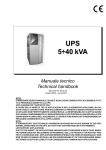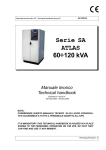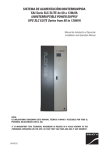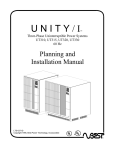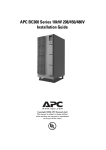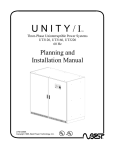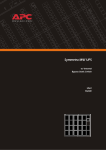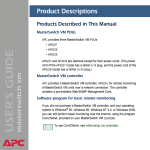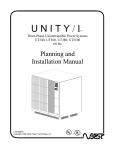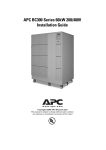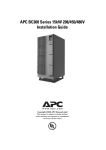Download APC 10-40kW 208/480V User guide
Transcript
APC BC300 Series 40kW 208/450/480V User Guide Copyright ©2002 APC Denmark ApS This manual is subject to change without notice and does not represent a commitment on the part of the vendor Thank You Thank you for choosing the APC BC Series. Please read this User Guide thoroughly prior to using the system as it provides important information on safe and efficient use. The use of this product must comply with national, federal, state, municipal and local codes. IMPORTANT SAFETY INSTRUCTIONS SAVE THESE INSTRUCTIONS Safety Symbols used in this manual WARNING! Indicates a hazard which, if not avoided, could result in injury or death. CAUTION! Indicates a hazard which, if not avoided, could result in damage to the product or other property. NOTICE! Read and pay attention to this important information. WARNING! This UPS unit contains hazardous AC and DC voltages. Only qualified electricians should connect the UPS, AC line and external batteries, and must be familiar with batteries and battery installation. Before installing, maintaining or servicing the UPS, shut off the UPS and disconnect all sources of AC and DC power. As the UPS has no built-in disconnection devices to switch off external AC and DC input power, ensure that disconnection devices are available as separate parts in connection with the installation. The installer must provide each external disconnecting device for this UPS system with labels with the following text: “Isolate the Uninterruptible Power Supply (UPS) as instructed in this guide before working on circuit” AC and/or DC voltage will always involve a potential risk of AC voltage at UPS output generated from either batteries or utility. To avoid equipment damage or personal injury, always assume that there may be voltage at UPS output. This system is equipped with an auto-start function. If activated, the system may start without warning. Refer to the “Programming” section for information on de-activation. TEST BEFORE YOU TOUCH! To reduce the risk of fire or electric shocks, install the UPS and external batteries in a temperature and humidity controlled indoor area, free of conductive contaminants. UPS batteries are high-current sources. Shorting battery terminals, DC terminals or DC busbars can cause severe arcing, equipment damage and injury. A short circuit can cause a battery to explode. Always wear protective clothing and eye protection and use insulated tools when working on batteries. CAUTION! This unit contains components sensitive to electrostatic discharge (ESD). If you do not follow the ESD procedures, you may cause severe damage to electronic components. PLEASE RECYCLE The shipping materials are recyclable. Please save for later use or dispose of them appropriately. 990-1403 2 User Guide APC BC300 Series 40kW 208/450/480V UPS Contents: 1.0 2.0 3.0 4.0 5.0 6.0 7.0 8.0 9.0 10.0 11.0 Introduction 4 1.1 4 Display Unit UPS Stop/Start 5 2.1 2.2 5 5 UPS Stop (for stand-by) UPS Start (from stand-by) Operation 6 3.1 3.2 3.3 7 8 9 Operation Modes Using the Keys Displaying Measurements Parameter Settings 11 Alarms and Events 13 5.1 5.2 5.3 5.4 13 13 14 23 Silencing the Audible Alarm Displaying the Alarm Log Alarm Messages Displaying the Events Log Maintenance and Testing 24 6.1 6.2 6.3 24 24 25 Preventive Maintenance Check Battery Monitor Test Battery Capacity Test Start-up and Shutdown Procedure 27 7.1 7.2 27 27 Start-up from Maintenance Bypass Shutdown Procedure Specifications 29 Options 31 9.1 9.1.1 9.1.2 9.1.3 9.2 9.2.1 9.2.2 9.2.3 9.2.4 9.2.5 9.2.6 9.2.7 9.2.8 31 31 31 31 31 31 32 32 32 32 32 32 32 Optional Hardware and Software Features Battery Temperature Communication Maintenance Optional Service Programs Start-Up Service Preventive Maintenance Visit On-Site Service Remote Monitoring Service External Battery Installation Service External Battery Start-up External Battery Preventive Maintenance Visit External Battery On-Site Service WARRANTY 33 10.1 10.2 33 33 Life Support Policy APC BC300 Series UPS Limited Factory Warranty How to Contact APC 35 990-1403 User Guide APC BC300 Series 40kW 208/450/480V UPS 3 Introduction 1.0 Introduction This UPS system is designed to offer reliable and problem-free power supply for several years. The system requires only a minimum of maintenance, but we recommend you follow the maintenance guidelines described in the “Maintenance & Testing” section of this User Guide. 1.1 Display Unit The display unit (located on the front of the UPS) is the link between the user and the UPS and consists of a display, an alarm LED indicator and a keyboard. The display reads parameters, measured values and alarm messages. Figure 1 NOTICE! Display accuracy is ±2%, ±1digit. 990-1403 4 User Guide APC BC300 Series 40kW 208/450/480V UPS UPS Stop/Start 2.0 UPS Stop/Start WARNING! AC voltage generated either from batteries or utility may be present at UPS output. Always disconnect AC input supply source, switch off UPS, AND switch off DC. TEST BEFORE YOU TOUCH! Some UPS systems have a factory-set auto-start feature, which automatically switches on the UPS whenever utility supply is switched on (AC line). See the “Parameter Settings” section in this User Guide for instructions on how to de-activate this function. Only qualified electricians should start up or shut down APC BC300 Series UPS systems, and instructions in the Installation Guide should be followed. The UPS must be completely shut down before service or before the UPS is taken out of operation for more than 24 hours. Although you cannot completely start or shut down the unit, you can switch the UPS into stand-by mode and return it to normal operation by following the instructions below. (In standby mode, the UPS does not provide output voltage.) 2.1 UPS Stop (for stand-by) To put the unit into stand-by mode, press the red control button inside the unit’s front door. 2.2 UPS Start (from stand-by) To take the unit out of stand-by and switch it back to normal operation, press the green control button inside the unit’s front door. . NOTICE! Make sure the UPS operates in normal operation for at least 12 hours every three months to recharge the batteries. 990-1403 User Guide APC BC300 Series 40kW 208/450/480V UPS 5 Operation 3.0 Operation The keyboard is used to program and control parameters and to display alarm messages and measured values. Figure 2 990-1403 6 User Guide APC BC300 Series 40kW 208/450/480V UPS Operation 3.1 Operation Modes The display automatically indicates which mode the unit is operating in. See Table 1 below for sample display messages and an explanation of each. Table 1: Operating Modes Sample Display Mode Operation Mode Description Normal Operation load power ##% The UPS is in the normal operation mode. During normal operation, utility (AC line) passes through the UPS and to the load. The inverter regulates the output and charges the batteries. The UPS measures all three phases, and the display reads out the% load of the highest loaded phase. Battery Operation time ## minutes When AC input is out of tolerance (outside programmed limits), the UPS is running in battery mode. The main static switch is open, and the inverter is powered from the batteries. The power is then fed to the loads. If the batteries are depleted, the unit will switch to standby mode (see below) and wait for utility to return in tolerance. If autostart is programmed to “ON,” the unit will automatically start about 30 seconds after utility has returned. If auto-start is programmed to “OFF,” you must start the unit manually by pressing the green button inside the front door. (See the “Parameter Settings” section in this User Guide.) Bypass Operation The AC input passes unregulated through the bypass static switch, through the main transformer, and to the loads. The UPS’ inverter is in stand-by and is synchronized to the utility, ready to transfer the unit to battery operation if utility voltage is out of tolerance. Economy Mode The unit has been programmed to operate in economy mode. The AC power flows in bypass, and the UPS will periodically transfer to normal operation to charge the batteries (at 7-day intervals by UPS default). The inverter is in stand-by and is synchronized to utility, ready to transfer to battery operation if utility voltage is out of tolerance. The output voltage is not regulated in this mode, but efficiency increases. Call APC Technical Support or your nearest APC office for more information on programming your APC BC300 Series UPS for Economy Mode. ** Stand-by ** Both static switches are open. The unit is not supplying output voltage. 990-1403 User Guide APC BC300 Series 40kW 208/450/480V UPS 7 Operation 3.2 Using the Keys Table 2: Using the keys Key Function Scroll up through lists of e.g. parameters, alarms, or events. Scroll down through lists of e.g. parameters, alarms, or events. Key Function Display the time and date. If the unit is in the parameter mode, use this key to change the setting of a parameter from “OFF” to “ON.” Display inverter current. Enter a value or exit a mode. Display output frequency. Display the alarm log. If the unit is in the parameter mode, this key changes the setting of a parameter from “ON” to “OFF.” Display utility (AC input) current. Display user parameters. Display battery current. Silence audible alarms. Display output current. Not used. Display utility (AC input) voltage. Display battery voltage. Display output voltage. 990-1403 8 User Guide APC BC300 Series 40kW 208/450/480V UPS Operation 3.3 Displaying Measurements The APC BC300 Series UPS measures several values during operation that you can display by pressing one or two keys. This section illustrates how to display the measurements, what a sample display of each measurement looks like, and what the display reads. If two keys are shown, press those keys simultaneously. The display values shown below are samples only. Table 3: Display Measurements (Examples) Key Sample Display Description Utility 1. voltage 210 210 210 Vac Utility (AC line) voltage is 3 x 210 Vac (L1-2, L2-3, L3-1). Utility 1. current 21 21 21 Aac Utility (AC line) current is 3 x 21 Aac (I1, I2, I3). Battery voltage 216 VDC Battery voltage is 216 VDC. Battery current 2 ADC (-30 ADC) Charging current is (+) 2 ADC. Discharging current is (-) 30 ADC. Inverter current 12 12 12 Aac Inverter current is 3 x 12 Aac. Output voltage 208 208 208 Vac Output voltage is 3 x 208 V (L1-2, L2-3, L3-1). Output current 15 15 15 Aac Output current is 3 x 15 Aac (I1, I2, I3). Output frequency 60 Hz Output frequency is 60 Hz. 990-1403 User Guide APC BC300 Series 40kW 208/450/480V UPS 9 Operation When two keys are shown, press those keys simultaneously. Keys Sample Display Description Battery temp. 25° C Battery temperature is 77° F (25° C) Output peak curr 19 19 19 Aac Output peak current is 3 x 19 Aac. Normal operation load power xx% 01.12.16 10.22.13 UTC Returns to “Normal operation” display and indicates the% load of the most fully loaded phase (leg). Year, month, day. Hour, minute, second. UTC = Universal Time Coordination. (This may be programmed to your time.) 990-1403 10 User Guide APC BC300 Series 40kW 208/450/480V UPS Parameter Settings 4.0 Parameter Settings User parameters allow you to define the UPS settings. You can view and program the parameters listed in Table 2 below. The parameters are easy to access and program: simply follow the five steps below. NOTICE! Make sure that you fully understand a parameter before changing it. Call APC Technical Support or your nearest APC office for assistance. 1. Press to display the user parameter list. 2. or Press to scroll through the list. 3. To switch a parameter “ON,” press . 4. To switch a parameter “OFF,” press 5. To exit the parameter list, press . . 990-1403 User Guide APC BC300 Series 40kW 208/450/480V UPS 11 Parameter Settings Table 4: Parameter Settings PARAMETER FACTORY SETTING DESCRIPTION Second Language OFF If you select ON, the APC BC300 Series displays all messages in its second language (Spanish). Adaptive slewrate ON OFF is used when utility frequency is unstable. Call APC Technical Support before changing this parameter. Battery monitor reset — Choose ON to reset the battery monitor alarm and remove battery monitor alarm messages from the alarm log and to reset all battery information (e.g. runtime); run a battery monitor test again (see the “Battery Monitor Test” section of this User Guide) to set battery information to the correct levels. This parameter is available only for UPSs with a battery monitor. Battery monitor test — This test measures the condition of the batteries. (See the “Battery Monitor Test” section of this User Guide). This parameter is available only for UPSs with a battery monitor. Battery capacity test — Measures back-up time (runtime) available. See the “Battery Capacity Test” section in this User Guide for more information. M3 start-up — Not applicable. Boost charge OFF Set to ON for 8 hours (programmable) of continuous boost (equalize) charge. For more information on changing the time to more or less than 8 hours, call APC Global Service. Bypass operation OFF Switch to ON for static bypass operation. The UPS must be programmed for static bypass operation before an external bypass switch is activated in order not to disturb the power to the load. While the UPS is operating in bypass, the batteries are not charged. Auto-start OFF Set to ON for auto-start after 30 seconds when utility (AC line) is applied. CAUTION: When this parameter is set to ON, the UPS automatically starts and powers the load whenever utility is available. When servicing the UPS or load, make sure this is set to OFF. 990-1403 12 User Guide APC BC300 Series 40kW 208/450/480V UPS Alarms and Events 5.0 Alarms and Events Alarms are indicated by a red light (above the left-hand corner of the display) and a 30-second acoustic signal. An alarm is registered in the alarm log as long as it is present. All alarms are also registered in an event logger and remain there in a stack with room for 250 events. The events are stored in order of occurance, with the latest event appearing first. 5.1 Silencing the Audible Alarm To silence the audible alarm, press The audible alarm will automatically silence itself after 30 seconds. NOTICE! Silencing the audible alarm does not correct the condition that caused the alarm. 5.2 Displaying the Alarm Log To find out why the UPS sounds an alarm, display the alarm log by following steps 1-4 below. The log shows all alarms currently active. Note each alarm! 1. Press 2. Press to access the alarm log. or to move through the alarm log. 3. If you press after displaying the last active alarm, the display will read: “No further alarm.” 4. To exit the alarm log press . 990-1403 User Guide APC BC300 Series 40kW 208/450/480V UPS 13 Alarms and Events 5.3 Alarm Messages Table 5: Possible Alarms Alarm Message Description Action Battery MCB is off The battery breaker is open. If bypass voltage is within tolerance, the unit transfers to static bypass operation. If not, the unit transfers to stand-by and does not supply output voltage. At the battery breaker, set the precharge/discharge switch to the precharge position and hold it in this position until the LED turns off. Precharge is very important to prevent damage to your equipment. After precharge, switch the battery breaker on. Battery Monitor Alarms The battery monitor test has found that the battery pack is near low runtime capacity or that the battery pack may have a problem. The unit’s status does not change, but when the unit operates on battery, runtime will be seriously reduced. Call APC Global Service to schedule battery maintenance. Battery Monitor Warning The battery monitor test has found that battery capacity is reduced (typically below 80%). The unit’s status does not change, but the unit will not be able to operate as long on battery (it will have reduced runtime). See the “Parameter Settings” section of this User Guide to display the parameters. Then, change the “Battery monitor reset” parameter to “ON.” This will clear the Battery Monitor Warning. Next, do a battery monitor test (see the “Battery Monitor Test” section). If the alarm starts again, call APC Global Service to schedule battery maintenance. Bypass freq. is out of tolerance The bypass frequency is out of tolerance (too high, low, or unstable). The unit may transfer to battery or stand-by operation; it cannot operate in static bypass. Ask an electrician to make sure that the correct input frequency is being supplied to the UPS. If so, and if this voltage is within the range accepted by the UPS, call APC Global Service. Bypass is moment. out of tolerance (This alarm occurs when there is a power outage) The bypass voltage was momentarily out of tolerance. The unit may transfer to battery or stand-by operation; it cannot operate in static bypass. Ask an electrician to make sure that the correct input voltage is being supplied to the UPS. If so, and if this voltage is within the range accepted by the UPS, call APC Global Service. Bypass is out of tolerance (This alarm occurs when there is a power outage) The bypass voltage is out of tolerance (too high or low). The unit may transfer to battery or stand-by operation; it cannot operate in static bypass. Ask an electrician to make sure that the correct input voltage is being supplied to the UPS. If so, call APC Global Service. 990-1403 14 User Guide APC BC300 Series 40kW 208/450/480V UPS Alarms and Events Table 5: Possible Alarms Charge reg. error (reg. = regulator) Failure in charge regulation. The unit transfers to battery until the “Low DC shutdown” alarm occurs; then, it transfers to stand-by and does not supply output voltage. Call APC Global Service. External service switch activated The external service bypass switch is in the line position. The unit is in stand-by and does not supply output voltage. However, the loads may be receiving power from the external manual bypass. Call APC Global Service. Fan fault If the fan monitoring option is installed, this alarm sounds if one or more of the fans are slowing down. The unit’s status does not change, but the problem may cause other high-temperature alarms that could change the unit’s status. Call APC Global Service. Fatal Error RAM1 data error Components on the main controller board have failed. Call APC Global Service. Fault in int. power supply There is a fault in the internal power supply unit (PSU). The UPS transfers to stand-by and does not supply output voltage. Call APC Global Service. High Battery Temperature The ambient battery temperature is higher than the set alarm level. The unit’s status does not change, but battery life could be affected. This alarm is often caused by high room temperature. Make sure the room temperature does not exceed 80° F (27° C). If so, cool down the room. If the temperature was below 80° F (27° C) at the time of the alarm, find the exhaust vents for the UPS fans and check to see if the fans are operating. Do not try to open the unit, and do not insert anything into a fan vent. If the fans are not operating, call APC Global Service. High DC Warning The monitored battery voltage is higher than the unit’s shutdown setting. Call APC Global Service. High DC Shutdown The monitored battery voltage is higher than the unit’s shutdown setting. The unit will switch to battery power to reduce DC bus voltage. Call APC Global Service. 990-1403 User Guide APC BC300 Series 40kW 208/450/480V UPS 15 Alarms and Events Table 5: Possible Alarms High output voltage (This alarm is usually only listed in the events log) The output voltage is higher than the alarm setting. The unit stays in the normal operation mode. If the alarm is not cleared, the unit will transfer to static bypass operation if bypass is within tolerance. If bypass is not within tolerance, the unit will transfer to stand-by and will not supply output voltage. If the alarm is still active, put the UPS into bypass by displaying the user parameters and changing “Bypass Operation” to “ON.” (See the “Parameter Settings” section in this User Guide). Then, call APC Global Service. High temp. choke The temperature in the main choke is too high. If the problem is not corrected soon, the unit will transfer to battery operation. Find the exhaust vents for the UPS fans and check to see if the fans are operating. Do not try to open the unit, and do not insert anything into a fan vent. If the fans are not operating, call APC Global Service. High temp. transformer The temperature in the main transformer is too high. If the problem is not corrected soon, the unit will transfer to stand-by and will not supply output voltage. Find the exhaust vents for the UPS fans and check to see if the fans are operating. Do not try to open the unit, and do not insert anything into a fan vent. If the fans are not operating, call APC Global Service. Inverter fuse blown One or more of the fuses at the output of the inverter are blown (F004, F005, F006). If bypass is within tolerance, the unit transfers to static bypass operation. If not, the unit transfers to stand-by and does not supply output voltage. Call APC Global Service. Inverter voltage error The output voltage is too high or too low. If the alarm was caused by high output voltage, the unit transfers to static bypass operation if bypass is within tolerance. If bypass is not within tolerance, the unit transfers to stand-by and does not supply output voltage. If the alarm was caused by low output voltage, the unit transfers to static bypass operation if bypass is within tolerance. If bypass is not within tolerance, the unit transfers to battery for five seconds and then transfers to stand-by and stops supplying output voltage. If the UPS is in stand-by, restart the UPS by pressing the green button inside the door. If the UPS will not restart, a user may have started an emergency power off (EPO) shutdown. Find out if the EPO shut down the UPS; if it did, find out why and make sure the emergency situation has passed. Then, reset the EPO and restart the unit by pressing the green button inside the door. If the unit will still not restart, call APC Global Service. 990-1403 16 User Guide APC BC300 Series 40kW 208/450/480V UPS Alarms and Events Table 5: Possible Alarms Low DC shutdown (This alarm is normal when the UPS has run on battery for a long time) The UPS has been running on battery power because of a power outage or problems in the AC input. Battery voltage has dropped below the shutdown setting, and the UPS has shut down. If bypass is within tolerance, the unit will transfer to static bypass operation. If not, the unit will transfer to stand-by and will not supply output voltage. If the UPS is programmed for auto-start, it will automatically restart when the power outage ends and AC input is again available. If the UPS is not programmed for auto-start, you can restart the UPS when the power outage ends by pressing the green button inside the door. Low DC warning (This alarm is normal when the UPS has run on battery for a while) The UPS has been running on battery power for a while because of a power outage or problems in the AC input. Battery voltage has fallen to the warning alarm setting. If the APC BC300 Series is operating on battery, the unit’s status will not change, but battery voltage will eventually drop to the shutdown setting. At this point, the unit will shut down and sound a “Low DC shutdown” alarm. If the “Low DC warning” alarm occurs during a battery capacity test, the unit transfers back to normal operation. If possible, restore AC input power to the UPS. If you cannot do this, prepare for a possible Low DC shutdown by shutting down the loads (protected equipment) connected to the UPS. If the unit has not been running on battery power, call APC Technical Support. Mains freq. is out of tolerance The utility (AC input) frequency is out of tolerance. The unit transfers to battery operation. If utility returns to a frequency within tolerance, the unit transfers back to normal operation. If not, the unit continues to run on battery until the “Low DC shutdown” alarm occurs. Then, if bypass is within tolerance, the unit transfers to bypass. If not, the unit transfers to stand-by and does not supply output voltage. Ask an electrician to make sure that the correct input frequency is available to the UPS. The electrician must correct any problems in input frequency. If input frequency is correct, call APC Global Service. Mains is moment. out of tolerance (This alarm occurs during a power outage) The utility (AC line voltage) was momentarily too high or too low. The unit transfers to battery; if utility returns to a frequency within tolerance, the unit transfers back to normal operation. If possible, restore AC input power to the UPS. If AC input is available to the UPS, ask an electrician to make sure that 1) the correct input voltage is available to the UPS. 2) this voltage is within an acceptable UPS range 990-1403 User Guide APC BC300 Series 40kW 208/450/480V UPS 17 Alarms and Events Table 5: Possible Alarms Mains is out of tolerance (This alarm occurs during a power outage) The utility (AC input) voltage is too high or too low, so the unit transfers to battery operation. If AC input returns to normal, the unit transfers back to normal operation. If not, the unit continues to run on battery until the “Low DC shutdown” alarm occurs. Then, if bypass voltage is within the range programmed into the UPS, the unit transfers to bypass. If not, the unit transfers to stand-by and does not supply output voltage. If possible, restore AC input power to the UPS. If AC input is available to the UPS, ask an electrician to make sure that 1) the correct input voltage is available to the UPS, and 2) this voltage is within a range the UPS will accept. OFF Button Pushed (If the alarm was caused by the Off button, it is in the events log) A user pushed the red “Off” button or activated an emergency power off shutdown. The unit switches to stand-by mode and does not supply output voltage. Restart the unit by pressing the green button inside the door. If the unit will not restart, the alarm was caused by an emergency power off (EPO) shutdown. Find out why this shutdown was activated and make sure the emergency situation has passed; then, restart the unit by deactivating the emergency power off shutdown. Output freq. is out of tolerance The output frequency is too high, low, or unstable (out of tolerance). The unit transfers to battery operation and runs on battery until the “Low DC shutdown” alarm occurs. Then, the unit transfers to bypass if bypass is within tolerance. If not, the unit transfers to stand-by and does not supply output voltage. Ask an electrician to make sure that the correct input frequency is being supplied to the UPS. Then, call APC Global Service. Output is moment. out of tolerance The output voltage was momentarily too high or too low (out of tolerance). If bypass is within tolerance, the unit transfers to static bypass operation. If not, the unit transfers to stand-by and does not supply output voltage. If other alarms are also active, troubleshoot these alarms first. If this is the only alarm, call APC Global Service. 990-1403 18 User Guide APC BC300 Series 40kW 208/450/480V UPS Alarms and Events Table 5: Possible Alarms Output is out of tolerance The output voltage is too high or too low (out of tolerance). If the alarm was caused by high output voltage, the unit transfers to static bypass operation if bypass is within tolerance. If bypass is not within tolerance, the unit transfers to stand-by and does not supply output voltage. If the alarm was caused by low output voltage, the unit transfers to static bypass operation if bypass is within tolerance. If bypass is not within tolerance, the unit transfers to battery for five seconds and then transfers to stand-by and stops supplying output voltage. If the UPS is in stand-by, restart the UPS by pressing the green button inside the door. If the UPS will not restart, a user may have started an emergency power off (EPO) shutdown. Find out if the EPO shut down the UPS; if it did, find out why and make sure the emergency situation has passed. Then, you can reset the EPO and restart the unit by pressing the green button inside the door. If the unit will still not restart, call APC Global Service. Overload load is over 100% The unit is loaded with more than nominal load on one or more phases. The UPS status does not change until it can no longer maintain the correct output voltage. Then, the unit transfers to static bypass operation if bypass is within tolerance. If not, the unit transfers to battery for five seconds; then, it transfers to standby and stops supplying output voltage. Disconnect equipment connected to the UPS until the load is below 100%. An electrician must connect these loads to another power source. If the alarm persists, call APC Global Service. Static switch 1 temp. shutdown The temperature on the heat-sink for the main static switch is higher than the shutdown level, and the main static switch has opened. The unit switches to battery operation. When the temperature falls below the shutdown level, the unit transfers back to normal operation. If the temperature does not fall to this level before the “Low DC Shutdown” alarm occurs, there will be no output to the load equipment. Find the vents for the UPS fans and check to see if the fans are operating. Do not try to open the unit, and do not insert anything into a fan vent. If the fans are not operating, call APC Global Service. If the fans are operating, make sure the room temperature is below 80° F (27° C). If not, cool down the room. if the room was already below this temperature, call APC Global Service. 990-1403 User Guide APC BC300 Series 40kW 208/450/480V UPS 19 Alarms and Events Table 5: Possible Alarms Static switch 1 temp. warning The temperature on the heat-sink for the main static switch is higher than the warning setting. The unit’s status does not change. However, if the temperature continues to rise, the unit will sound a “Static switch 1 temp. shutdown” alarm. Find the vents for the UPS fans and check to see if the fans are operating. Do not try to open the unit, and do not insert anything into a fan vent. If the fans are not operating, call APC Global Service. If the fans are operating, make sure the room temperature is below 80° F (27° C). If not, cool down the room. if the room was already below this temperature, call APC Global Service. Static switch 2 temp. shutdown The temperature on the heat-sink for the bypass static switch is higher than the shutdown level and the bypass static switch has opened. The unit switches to battery operation until the temperature falls below the shutdown level; then, it transfers back to normal operation. If the temperature does not fall to this level before the “Low DC shutdown” alarm occurs, there will be no output to the load equipment. Find the vents for the UPS fans and check to see if the fans are operating. Do not try to open the unit, and do not insert anything into a fan vent. If the fans are not operating, call APC Global Service. If the fans are operating, make sure the room temperature is below 80° F (27° C). If not, cool down the room. if the room was already below this temperature, call APC Global Service. Static switch 2 temp. warning The temperature on the heat-sink for the bypass static switch is higher than the warning setting. The unit’s status does not change. However, if the temperature continues to rise, the unit will sound a “Static switch 2 temp. shutdown” alarm. Find the vents for the UPS fans and check to see if the fans are operating. Do not try to open the unit, and do not insert anything into a fan vent. If the fans are not operating, call APC Global Service. If the fans are operating, make sure the room temperature is below 80° F (27° C). If not, cool down the room. if the room was already below this temperature, call APC Global Service. Synchronization error (This alarm occurs during a power outage) The inverter output is not synchronized to the utility (AC input). The unit will transfer to battery operation until the “Low DC shutdown” alarm sounds. If the unit can synchronize to utility again before this event occurs, it will transfer back to normal operation. If this alarm occurs during the initial start-up, an electrician must check the phase rotation. If this alarm occurs while the unit is connected to a generator, the unit may be having problems synchronizing to the generator. Call APC Global Service. If the alarm does not occur during the initial start-up and the UPS is not connected to a generator, call APC Global Service. 990-1403 20 User Guide APC BC300 Series 40kW 208/450/480V UPS Alarms and Events Table 5: Possible Alarms TSM 1 temp. shutdown Inverter module 1 has shut down because the temperature on the heat-sink is higher than the shutdown level. If bypass is within tolerance, the unit transfers to static bypass operation. If not, the unit transfers to stand-by mode and does not supply output voltage. Find the vents for the UPS fans and check to see if the fans are operating. Do not try to open the unit, and do not insert anything into a fan vent. If the fans are not operating, call APC Global Service. If the fans are operating, make sure the room temperature is below 80° F (27° C). If not, cool down the room. if the room was already below this temperature, call APC Global Service. TSM 1 temp. warning The temperature on the heat-sink for inverter module 1 has exceeded the warning setting. The unit’s status does not change. However, if the temperature continues to rise, the unit will sound a “TSM 1 temp. shutdown” alarm. Find the vents for the UPS fans and check to see if the fans are operating. Do not try to open the unit, and do not insert anything into a fan vent. If the fans are not operating, call APC Global Service. If the fans are operating, make sure the room temperature is below 80° F (27° C). If not, cool down the room. if the room was already below this temperature, call APC Global Service. TSM 2 temp. shutdown Inverter module 2 has shut down because the temperature on the heat-sink is higher than the shutdown level. If bypass is within tolerance, the unit transfers to static bypass operation. If not, the unit transfers to stand-by and does not supply output voltage. Find the vents for the UPS fans and check to see if the fans are operating. Do not try to open the unit, and do not insert anything into a fan vent. If the fans are not operating, call APC Global Service. If the fans are operating, make sure the room temperature is below 80° F (27° C). If not, cool down the room. if the room was already below this temperature, call APC Global Service. TSM 2 temp. warning The temperature on the heat-sink for inverter module 2 is higher than the warning setting. The unit’s status does not change. However, if the temperature continues to rise, the unit will sound a “TSM 2 temp. shutdown” alarm. Find the vents for the UPS fans and check to see if the fans are operating. Do not try to open the unit, and do not insert anything into a fan vent. If the fans are not operating, call APC Global Service. If the fans are operating, make sure the room temperature is below 80° F (27 °C). If not, cool down the room. if the room was already below this temperature, call APC Global Service. 990-1403 User Guide APC BC300 Series 40kW 208/450/480V UPS 21 Alarms and Events Table 5: Possible Alarms TSM 3 temp. shutdown Inverter module 3 has shut down because the temperature on the heat-sink is higher than the shutdown level. If bypass is within tolerance, the unit transfers to static bypass operation. If not, the unit transfers to standby and does not supply output voltage. Find the vents for the UPS fans and check to see if the fans are operating. Do not try to open the unit, and do not insert anything into a fan vent. If the fans are not operating, call APC Global Service. If the fans are operating, make sure the room temperature is below 80° F (27° C). If not, cool down the room. if the room was already below this temperature, call APC Global Service. TSM 3 temp. warning The temperature on the heat-sink for inverter module 3 is higher than the warning setting. The unit’s status does not change. However, if the temperature continues to rise, the unit will sound a “TSM 3 temp. shutdown” alarm. Find the vents for the UPS fans and check to see if the fans are operating. Do not try to open the unit, and do not insert anything into a fan vent. If the fans are not operating, call APC Global Service. If the fans are operating, make sure the room temperature is below 80° F (27° C). If not, cool down the room. if the room was already below this temperature, call APC Global Service. 990-1403 22 User Guide APC BC300 Series 40kW 208/450/480V UPS Alarms and Events 5.4 Displaying the Events Log The events log is a list of the last 250 alarms and operational modes. This log includes the time and date of each event. Most entries in this log will be alarms (see the “Alarms and Events” section in this User Guide for a description of alarms). Other entries describe operating modes (see the “Operation Modes” section in this User Guide for details); the table below lists and describes these Event Log messages. 1. To access the events log, press both 2. Use the and and at the same time. keys to scroll through the log. 3. To display the time and date the alarm or other event occurred, press Sample display: . 01.12.16 (Year, month, date) 10.22.13 UTC (Hour, minute, second. UTC = Universal Time Coordination.) 4. If you press event.” after displaying the last event in the log, the display will show “No further 5. To exit the events log, press . Table 6: Log Messages Mode Description Main processor unit (MPU) is reset The UPS was completely switched off. Stand-by The UPS was in stand-by mode. Normal operation The UPS was in normal operation. Bypass operation The UPS was in bypass operation. Battery operation The UPS was in battery operation. Economy operation The UPS was programmed to operate in economy mode. 990-1403 User Guide APC BC300 Series 40kW 208/450/480V UPS 23 Maintenance and Testing 6.0 Maintenance and Testing APC recommends a periodic preventive maintenance check every six months. APC also recommends that the cooling fans be replaced every three years. 6.1 Preventive Maintenance Check At the preventive maintenance check, a qualified service technician should: • Check all wiring connections. • Inspect and clean the unit. • Check the batteries. • Check the AC and DC meter functions. • Perform a battery capacity or battery monitor test. (See the sections “Battery Monitor Test” and “Battery Capacity Test” in this User Guide.) • Check all modes of operation. • Perform a power outage test. Safety precautions must be observed while performing maintenance checks. For more information on preventive maintenance checks, or to schedule a maintenance check with an APC-authorized field service representative, call APC Global Service or the nearest APC office. 6.2 Battery Monitor Test NOTICE! If you are using UPS contacts for a communication link, take the necessary precautions so this test will not cause a premature shutdown. See your software documentation for more information. The battery monitor is optional for units with external batteries. The steps on the next page illustrate how to start a battery monitor test. This test measures the condition of the batteries and compares it to data programmed into the unit. The test discharges the batteries to about 75% of their capacity. During this test, the unit checks the applied load and the ambient temperature of the batteries. The unit then compares the results of the test with its programmed data. If the unit determines that the condition of the batteries is acceptable, it returns to normal operation. If the test determines that the condition of the batteries is unacceptable, the unit will sound either a “Battery monitor warning” alarm or a “Battery monitor alarm.” See Possible Alarms table 5 for more information on these alarms. If you would like the unit to automatically perform a battery monitor test on a regular basis (default = every 90 days), call the nearest APC office for more information. NOTICE! The information programmed into the unit is based on the size and type of batteries that were installed when the unit was sold. If the battery configuration changes, this test will not be accurate for the new configuration. Call the nearest APC office for more information. 990-1403 24 User Guide APC BC300 Series 40kW 208/450/480V UPS Maintenance and Testing To perform a battery monitor test: 1. Press to display the user parameters. 2. Press test.” or 3. Press min.” to start the battery monitor test. The display shows “Batt. operation time > xxx to scroll through parameters until the display shows “Battery monitor (“xxx” = the minutes of runtime remaining. This number will fluctuate during the test.) 4. When the test is complete, the display will show “Normal operation load power xx%” if the batteries are in acceptable condition. If the test has determined that the condition of the batteries is unacceptable, the unit will display either a “Battery monitor warning” or “Battery monitor alarm.” See the “Alarm Messages” section for a detailed description of these alarms. 6.3 Battery Capacity Test NOTICE! If you are using UPS contacts for a communication link, take the necessary precautions so this test will not cause a premature shutdown. See your software documentation for more information. The battery capacity test discharges the batteries to the “Low DC warning” level and displays the estimated runtime. This estimate is only correct for the unit’s condition at the time of the battery capacity test. If the load changes and you would like to display the estimated runtime, you must perform this test again. After a battery capacity test, the unit must charge the batteries for at least eight hours before full battery capacity and full runtime have been restored. To perform a battery capacity test, follow these steps: 1. Press to display the user parameters. 2. Press or to scroll through the parameters until the display shows this: Battery capacity test: xxx (“xxx” = the backup time from the last test). If the test has never been performed before or if the test has been aborted, the display will show “???.” 3. Press to abort the test or “Batt. operation time xxx min.” to continue. The display shows 4. If you wish to abort the test while it is in progress, follow these steps: 990-1403 User Guide APC BC300 Series 40kW 208/450/480V UPS 25 Maintenance and Testing a. Display the user parameter list by pressing . b. Use the arrow keys to scroll through the parameters until the display shows “Battery capacity test: xxx.” c. Switch the battery capacity test “OFF” by pressing . 5. Wait until the display shows “Normal operation load power xx%” and a short alarm sounds. 6. Press . The display will show “Battery capacity test: xxx.” (“xxx” = the estimated backup time in minutes) 7. Press to exit the user parameter list. 990-1403 26 User Guide APC BC300 Series 40kW 208/450/480V UPS Start-up and Shutdown Procedure 7.0 Start-up and Shutdown Procedure 7.1 Start-up from Maintenance Bypass This section contains instructions on how to start the UPS from maintenance bypass. The steps in this procedure apply to units with an APC-supplied Maintenance Bypass Panel. 1. Make sure that the following switches are in the following positions: The UPS AC disconnect switch should be “OFF”. The UPS bypass switch should be on “LINE”. The battery breaker should be “OFF”. 2. Switch the UPS AC disconnect switch “ON”. The UPS display should show “System type xxkVA xxxV”. 3. Within 20 seconds, the UPS display should show **Stand-by** and an audible alarm should sound. 4. Ensure that the external battery breaker for the battery system is set to “OFF”. 5. Turn the pre-charge/discharge switch to the “pre-charge” position and keep it in this position until the LED turns off. 6. Switch the battery breaker “ON”. 7. Press the green “on” button located inside the front door of the UPS. The UPS display should show “Normal operation load power xx%”. 8. Program the unit into static bypass operation: a. Press to access the user parameters. b. Press the c. Press to turn static bypass operation on. The display should show “Bypass operation”. or key until the display shows “Bypass operation: OFF”. 9. Set the UPS bypass switch to “UPS”. 10. Program the unit to normal operation: a. Press b. Press the c. Press to turn static bypass operation off. The display should show “Normal operation load power xx%”. 7.2 to access the user parameters. or key until the display shows “Bypass operation: ON”. Shutdown Procedure WARNING After shutting down the unit, wait at least five minutes before removing any access panels or covers. Access panels should be removed by authorized service personnel only. After the UPS has been shut down, the unit may still contain high voltages. TEST BEFORE YOU TOUCH! Before continuing, read the warnings on the inside front cover of this manual. 990-1403 User Guide APC BC300 Series 40kW 208/450/480V UPS 27 Start-up and Shutdown Procedure This section contains information on how to shut down the UPS from normal operation mode. This procedure applies to units with an APC-supplied Maintenance Bypass Panel. 1. If you have shut the loads down: Move on to step 2. If the loads are to remain powered: Program the unit into static bypass operation: a. Press to access the user parameters. b. Press the c. Press to turn static bypass operation on. The display should show “Bypass operation”. d. Set the UPS bypass switch to “BYPASS”. or key until the display shows “Bypass operation: OFF”. 2. Press the red “OFF” button located inside the UPS front door. 3. Set the UPS AC disconnect switch to “OFF”. 4. Switch the battery breaker “OFF” 5. Hold the pre-charge/discharge switch in the “discharge” position until the LED turns off. To restart the unit, see the section “Start-up from Maintenance Bypass” above. 6. (Optional) If the loads are not to be powered, turn off all AC power sources to the UPS and Maintenance Bypass Panel. 990-1403 28 User Guide APC BC300 Series 40kW 208/450/480V UPS Specifications 8.0 Specifications For a complete list of specifications, see the APC BC300 Series Installation Guide. Table 7: General Specifications Utility tolerance +10%, —15% (programmable) Bypass tolerance ±10% (programmable) Input frequency ±6% (programmable) 60 Hz Output frequency - utility synchronized: 60 Hz ±6% - free running: 60 Hz ±0.1% Current distortion 0-5% Tolerance - symmetrical load: ±1%, static. - asymmetrical load: ±3%, static. (100% imbalance, provided output current rating is not exceeded.) - load step 0-100: ±5%. Distortion (linear load) 0-3% Overload capacity - normal operation, 1 minute 250% - normal operation, 10 minutes 150% - battery operation, 1 minute 150% - battery operation, 10 minutes 125% Audible noise (dBa) dBa Maximum Humidity (non condensing) 95% Efficiency 95% For Users in the United States Only This equipment has been tested and found to comply with the limits for a Class A digital device, pursuant to Part 15 of the FCC rules. These limits are designed to provide reasonable protection against harmful interference when the equipment is operated in a commercial environment. This equipment generates, uses, and can radiate radio frequency energy and, if not installed and used in accordance with the Installation Guide, may cause harmful interference to radio communications. Operation of this equipment in a residential area is likely to cause harmful interference, in which case the user will be required to correct the interference at his/her own expense. 990-1403 User Guide APC BC300 Series 40kW 208/450/480V UPS 29 Specifications For Users in Canada This digital apparatus does not exceed the Class A limits for radio noise emissions from digital apparatus set out in the Radio Interference Regulations of the Canadian Department of Communications. 990-1403 30 User Guide APC BC300 Series 40kW 208/450/480V UPS Options 9.0 Options APC offers many options for the APC BC300 Series UPSs. For more information, contact your local APC office. Note that some options only apply to certain models. 9.1 Optional Hardware and Software Features 9.1.1 Battery Temperature Compensation: Enables the UPS to adapt the charging voltage to the battery temperature. This is for units with external batteries and this option monitors the temperature in one battery cabinet. 9.1.2 Communication Interface Board: If you would like to use shutdown software or remote monitoring, your UPS must have this internal circuit board. The board offers three methods of communicating with the UPS: 1. Normally open or normally closed contacts that indicate UPS ON, bypass operation, battery operation, and low battery. (You can choose this method for an AS/400 monitoring system.) 2. RS232 Serial Communications port. 3. Zero to 20 mA current loop. Fan Monitor: If the unit’s fans are not functioning properly, this option will activate a “Fan fault” alarm. 9.1.3 Maintenance Bypass Panel: An external bypass switch lets you conveniently transfer your protected load equipment to direct AC input power when it is time to service the UPS. The cabinet includes an AC disconnect. Parallel Board: This option allows your qualified installer to connect two or more units in parallel. The parallel board ensures proper control of parallel units and proper load sharing between the units. Each unit to be connected in parallel requires one of these boards. Each board includes 23 feet (7 meters) of interconnection cable. An APC Application Engineer should be involved in all parallel unit installations. Call APC Global Service or the nearest APC office for details. 9.2 Optional Service Programs Contact APC or visit www.apc.com for further information on a large range of end-to-end service and support which supplements the APC BC300 Series UPS Limited Factory Warranty. 9.2.1 Start-Up Service This service verifies that the APC system has been properly installed and includes comprehensive tests, correct start-up and basic customer training on usage. Performed during normal business hours. Does not include electrical installation or wiring work. 990-1403 User Guide APC BC300 Series 40kW 208/450/480V UPS 31 Options 9.2.2 Preventive Maintenance Visit Provides a single visit to examine the status and health of the APC system, to ensure proper operation over time. A visual and electronic inspection is performed to ensure that the system is performing to all defined technical and environmental specifications. The service is performed during normal business hours. 9.2.3 On-Site Service Provides 1-year On-Site Repair Service on APC equipment and 7x24 Telephone Technical Support. Response time differs by contracts. Based on availability the following contracts are offered: best endeavour, next business day, next day and 4-hours. Parts, internal batteries (if applicable), labor and travel are included. 9.2.4 Remote Monitoring Service Provides 7x24 remote monitoring of your APC hardware via APC’s Network Operation Center. Remote Monitoring Service is included for free during the first six months. 9.2.5 External Battery Installation Service This service provides APC authorized personnel to install external batteries into racks or cabinets. APC will energize and check functionality of the battery system in all modes, to ensure compliance with Manufacturers technical specifications. Does not include wiring or cabling. Performed during normal business hours 9.2.6 External Battery Start-up Provides an APC authorized engineer to perform Start-Up of external standard APC battery solutions for 208V/480V systems or DC systems. The engineer will energize and check the functionality of the battery system in all modes to ensure compliance with manufacturers technical specifications. The External Battery Start-Up will be performed in conjunction with the Start Up of the UPS/power system. 9.2.7 External Battery Preventive Maintenance Visit This service provides external battery inspection and testing to ensure proper operation over time. Performed whenever the customer requires to schedule the visit - including weekends & holidays. 9.2.8 External Battery On-Site Service Provides a 1-year maintenance contract on external battery solutions, to ensure optimum battery lifetime and performance. This service includes: 1-Year On-Site repair on APC approved external batteries, including spare parts, labor and travel expenses. The External Battery On-Site Service response time is equivalent to the response time of the APC hardware On-Site Service contract. 990-1403 32 User Guide APC BC300 Series 40kW 208/450/480V UPS WARRANTY 10.0 WARRANTY 10.1 Life Support Policy As a general policy, American Power Conversion (APC) does not recommend the use of any of its products in life support applications where failure or malfunction of the APC product can be reasonably expected to cause failure of the life support device or to significantly affect its safety or effectiveness. APC does not recommend the use of any of its products in direct patient care. APC will not knowingly sell its products for use in such applications unless it receives in writing assurances satisfactory to APC that (a) the risks or injury or damage have been minimized, (b() the customer assumes all such risks, and (c) the liability of American Power Conversion is adequately protected under the circumstances. Examples of devices considered to be life support devices are neonatal oxygen analysers, nerve stimulators (whether used for anaesthesia, pain relief, or other purposes), autotransfusion devices, blood pumps, defibrillators, arrhythmia detectors and alarms, pacemakers, hemodialysis systems, peritoneal dialysis systems, neonatal ventilator incubators, ventilators for both adults and infants, anaesthesia ventilators, infusion pumps, and any other device designated as “critical” by the U.S.F.D.A. Hospital grade wiring devices and leakage current may be ordered as options on many APC UPS systems. APC does not claim that units with this modification are certified or listed as Hospital Grade by APC or any other organization. Therefore these units do not meet the requirements for use in direct patient care. 10.2 APC BC300 Series UPS Limited Factory Warranty APC warrants that the unit, when properly installed and commissioned by APC or APC authorized service personnel, shall be free from defects in materials and workmanship for a period of (1) year from the date of installation or maximum 18 months after manufacturing. In the event that the unit fails to meet the foregoing warranty, APC shall for a period of one (1) year repair or replace any defective parts, without charge for on-site labor and travel if trained & authorized APC personnel has conducted start-up of the unit. An APC Start-Up Service must be performed/completed by APC or service personnel authorized by APC or the on-site factory warranty will be voided and replacement of defective parts only will be covered. APC shall have no liability and no obligation to repair the installed unit if non-authorized APC personnel performed the start-up and such start-up caused the unit to be defective. APC SHALL NOT BE LIABLE UNDER THE WARRANTY IF ITS TESTING AND EXAMINATION DISCLOSE THAT THE ALLEGED DEFECT IN THE PRODUCT DOES NOT EXIST OR WAS CAUSED BY PURCHASER’S OR ANY THIRD PERSON’S MISUSE, NEGLIGENCE, IMPROPER INSTALLATION OR TESTING, UNAUTHORIZED ATTEMPTS TO REPAIR OR MODIFY, OR ANY OTHER CAUSE BEYOND THE RANGE OF THE INTENDED USE, OR BY ACCIDENT, FIRE, LIGHTNING OR OTHER HAZARD. THERE ARE NO WARRANTIES, EXPRESSED OR IMPLIED, BY OPERATION OF LAW OR OTHERWISE, OF PRODUCTS SOLD, SERVICED OR FURNISHED UNDER THIS AGREEMENT OR IN CONNECTION HEREWITHIN. APC DISCLAIMS ALL IMPLIED WARRANTIES OF MERCHANTABILITY, SATISFACTION AND FITNESS FOR A PARTICULAR PURPOSE. APC’S EXPRESS WARRANTIES WILL NOT BE ENLARGED, DIMINISHED, OR AFFECTED BY AND NO OBLIGATION OR LIABILITY WILL ARISE OUT OF, APC’S RENDERING OF TECHNICAL OR OTHER ADVICE OR SERVICE IN CONNECTION WITH THE PRODUCTS. THE FOREGOING WARRANTIES AND REMEDIES ARE EXCLUSIVE AND IN LIEU OF ALL OTHER WARRANTIES 990-1403 User Guide APC BC300 Series 40kW 208/450/480V UPS 33 WARRANTY AND REMEDIES. THE WARRANTIES SET FORTH ABOVE, CONSTITUTE APC’S SOLE LIABILITY AND PURCHASER’S EXCLUSIVE REMEDY FOR ANY BREACH OF SUCH WARRANTIES. APC’S WARRANTIES RUN ONLY TO PURCHASER AND ARE NOT EXTENDED TO ANY THIRD PARTIES. IN NO EVENT SHALL APC, ITS OFFICERS, DIRECTORS, AFFILIATES OR EMPLOYEES BE LIABLE FOR ANY FORM OF INDIRECT, SPECIAL, CONSEQUENTIAL OR PUNITIVE DAMAGES, ARISING OUT OF THE USE, SERVICE OR INSTALLATION, OF THE PRODUCTS, WHETHER SUCH DAMAGES ARISE IN CONTRACT OR TORT, IRRESPECTIVE OF FAULT, NEGLIGENCE OR STRICT LIABILITY OR WHETHER APC HAS BEEN ADVISED IN ADVANCE OF THE POSSIBILITY OF SUCH DAMAGES. 990-1403 34 User Guide APC BC300 Series 40kW 208/450/480V UPS How to Contact APC 11.0 How to Contact APC APC Corporate 132 Fairgrounds Road West Kingston, RI 02892 USA Tel.: Fax: +1 401 789-5735 +1 401 789-3710 Pre-sales Technical Support +1 877-474-5266 Post-sales Technical Support +1 877-287-7835 Web: www.apc.com/support 990-1403 User Guide APC BC300 Series 40kW 208/450/480V UPS 35 How to Contact APC 990-1403 36 User Guide APC BC300 Series 40kW 208/450/480V UPS




































